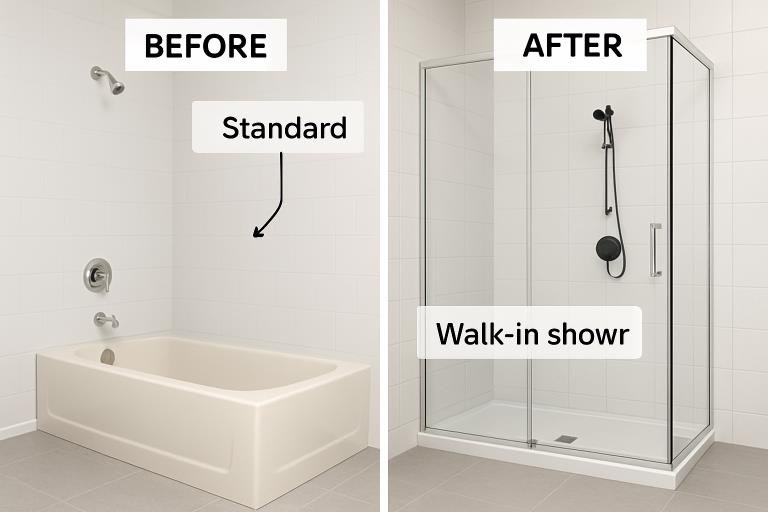Bathroom Design Trends Shaping Modern Renovations
A desire for seamless functionality, easy maintenance, and spa-like aesthetics increasingly influences modern bathroom renovations. Homeowners are leaning toward open layouts that favor clean lines, light color palettes, and expansive glass enclosures. The focus is on streamlining daily routines and utilizing every square foot efficiently, making features like walk-in showers more popular. For those considering a home upgrade, seeking out bathtub to shower conversion services can be the first step toward transforming an outdated space into an accessible, modern retreat. These services handle plumbing, waterproofing, and design intricacies, removing the guesswork from your remodel and ensuring lasting quality.
Why Homeowners Are Switching from Tubs to Showers
The trend of replacing bathtubs with showers is accelerating for several reasons. Showers require less cleaning, pose fewer safety risks for children and older adults, and save valuable bathroom space. Many individuals with busier lifestyles find showers fit more naturally into their daily routines, while others appreciate the improved accessibility of barrier-free entry. In real estate, homes with stylish, well-designed showers enjoy enhanced appeal and potentially higher resale values. Another significant draw is energy and water savings: Showers, especially those equipped with low-flow fixtures, consume far less water than traditional tubs. These practical and eco-conscious benefits make the switch appealing for many homeowners, including those planning to age in place or families seeking easy-to-clean solutions.
Planning Your Tub to Shower Conversion
A successful bathroom upgrade begins with thoughtful planning. Start by measuring your existing tub and bathroom layout to assess the possibilities. Next, establish your budget, allowing flexibility for unexpected issues like plumbing updates or water damage repair. Consider your lifestyle needs—do you prefer the luxurious appeal of rainfall showerheads, a practical bench, or in-shower shelving for storage? Engaging reputable contractors early is crucial for navigating design feasibility and building codes. Gathering design inspiration can help you identify materials, layouts, and finishing touches that match your vision and budget.
Choosing Materials and Improving Accessibility
Selecting high-quality, water-resistant materials ensures the longevity of your new shower. Popular options include non-slip ceramic or porcelain tiles, seamless acrylic walls, and tempered safety glass enclosures. When planning for accessibility, consider universal design principles: low-threshold entries, integrated grab bars, and built-in seating make the shower safer and easier for individuals of all ages and abilities. For homes with multiple generations or those anticipating future mobility needs, these improvements can make everyday routines more comfortable and support long-term independence. Consult bathroom designers or occupational therapists for ideas tailored to your unique requirements.
Cost Considerations and Budgeting Tips
Tub to shower conversions typically range from $3,000 to $8,000 depending on factors such as bathroom size, materials selected, and structural changes. Homeowners can control costs by keeping plumbing in its original location, choosing prefabricated shower units, or completing minor tasks like painting themselves. Clear, written estimates and a prioritized wish list help to prevent scope creep and unexpected expenses. Look for seasonal discounts from suppliers or local contractors to stretch your renovation dollars. Investing in durable, easy-to-maintain finishes can save money—and time—over the years by reducing the frequency of repairs and cleaning.
Safety and Compliance: Key Factors to Consider
Prioritizing safety ensures a bathroom remodel is comfortable and hazard-free. Building codes govern everything from waterproofing and electrical systems to venting and support structures. Many communities also stipulate standards for accessibility, particularly in homes where aging-in-place is a goal. Before demolition begins, confirm permitting requirements with your local city or county office. This not only protects your investment but also guarantees the remodel meets current safety and accessibility benchmarks—vital for both peace of mind and future resale.
Step-By-Step Guide to a Successful Conversion
- Inspect the space for existing water damage or mold and address any issues before removal begins.
- Determine your preferred shower type and layout—curb-less entry, glass enclosure, or tiled bench.
- Remove the bathtub, shut off the water, and disconnect plumbing and fixtures safely.
- Prepare the floor, install a waterproof shower base, and reroute plumbing if necessary.
- Add moisture-resistant wall panels or tile, thoroughly sealing every joint to prevent leaks.
- Install the shower door, glass panels, or a stylish waterproof curtain.
- Complete the space with chosen fixtures, lighting upgrades, and safety features such as grab bars or anti-slip mats.
For complicated projects, consider hiring professionals. Their expertise ensures quality workmanship and helps avoid common pitfalls.
Real-Life Examples: Before and After Stories
Transformations speak for themselves. In one suburban bungalow, removing a bulky tub and favoring a streamlined walk-in shower created room for added storage and brought a modern touch to a cramped space. Another homeowner, seeking independence after knee surgery, replaced her bathtub with a barrier-free shower, improving both comfort and confidence. These stories underscore how personalized upgrades can dramatically enhance day-to-day living.
Environmental Impact and Water Savings
Modern showers offer substantial environmental benefits. According to the Environmental Protection Agency (EPA), a five-minute shower using a WaterSense-labeled showerhead uses as little as 10 gallons, whereas filling a bathtub can use 30-50 gallons. This efficiency reduces household water bills and contributes to broader water conservation efforts—a crucial step in sustainable home management. For those motivated by green living, upgrading fixtures and minimizing waste during remodeling can further amplify eco-friendly results.
Conclusion
A bathtub-to-shower conversion is more than just a trend—it’s a practical investment in comfort, safety, and modern living. From improving accessibility to reducing maintenance and saving water, the benefits extend well beyond aesthetics. With thoughtful planning, quality materials, and expert installation, homeowners can transform daily routines and long-term property value. Whether motivated by convenience, sustainability, or design, this upgrade creates a functional and future-ready bathroom.



